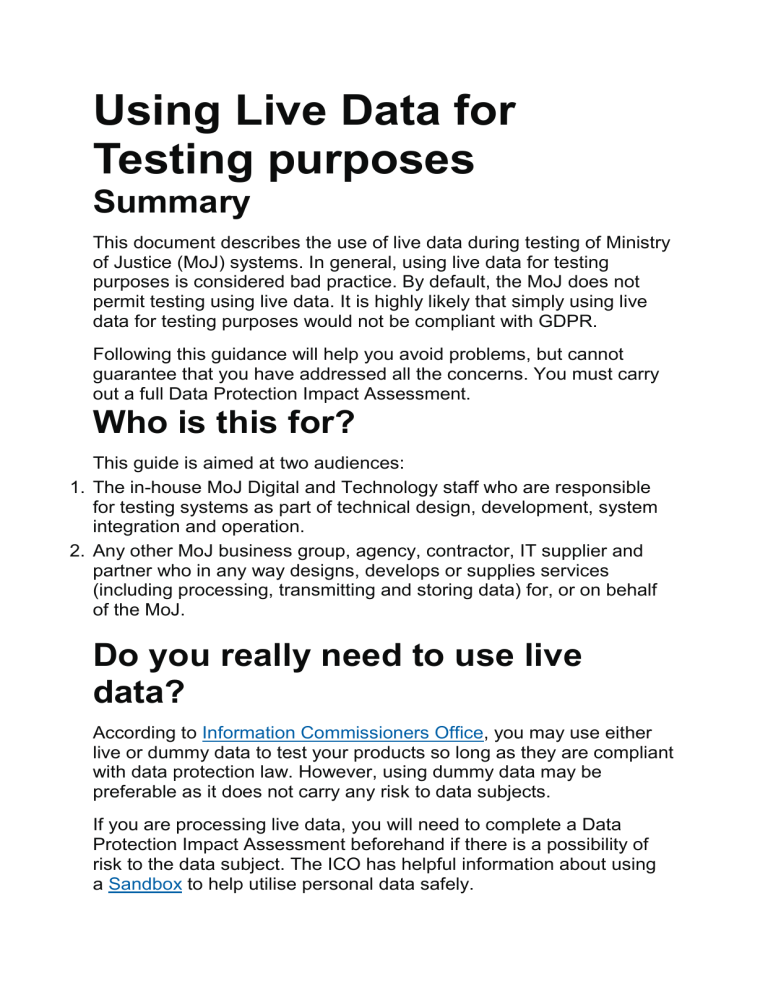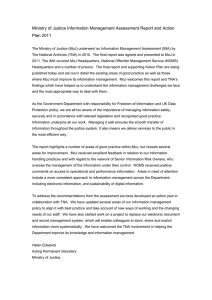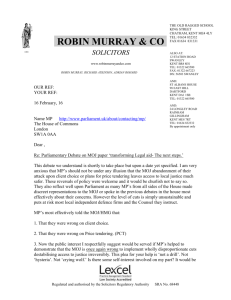
Using Live Data for Testing purposes Summary This document describes the use of live data during testing of Ministry of Justice (MoJ) systems. In general, using live data for testing purposes is considered bad practice. By default, the MoJ does not permit testing using live data. It is highly likely that simply using live data for testing purposes would not be compliant with GDPR. Following this guidance will help you avoid problems, but cannot guarantee that you have addressed all the concerns. You must carry out a full Data Protection Impact Assessment. Who is this for? This guide is aimed at two audiences: 1. The in-house MoJ Digital and Technology staff who are responsible for testing systems as part of technical design, development, system integration and operation. 2. Any other MoJ business group, agency, contractor, IT supplier and partner who in any way designs, develops or supplies services (including processing, transmitting and storing data) for, or on behalf of the MoJ. Do you really need to use live data? According to Information Commissioners Office, you may use either live or dummy data to test your products so long as they are compliant with data protection law. However, using dummy data may be preferable as it does not carry any risk to data subjects. If you are processing live data, you will need to complete a Data Protection Impact Assessment beforehand if there is a possibility of risk to the data subject. The ICO has helpful information about using a Sandbox to help utilise personal data safely. Data used for testing purposes must have characteristics that are as close as possible to operational data. But that is not the same thing as needing to use live data. 1. 2. 3. 4. 5. 6. Check whether you really need to use live data, by considering the following questions: Speed: What are your time requirements for test data provisioning? Cost: What is an acceptable cost to create, manage and archive test data? Quality: What are the important factors to consider related to test data quality? Security: What are the privacy implications of these two sources of test data? Simplicity: Is it easy for testers to get the data they need for their tests? Versatility: Can the test data be used by any testing tool or technology? The best test data simulates live operations data. Note: It is important that test data is protected to the same standard as the live data. This is to ensure that details of the system design and operation are not compromised. To protect test data, the following principles should be followed: The test manager must authorise the use of test data. Test data should be erased from a testing environment immediately after the testing is complete or when no longer required. The copying and use of test data should be logged to provide an audit trail. Note: In the absence of an allocated test manager for a project, refer to the system owner. By default: Data used for testing must not contain any live data. Using live data containing personal information is prohibited. In exceptional circumstances, the use of live system data may be permitted. Permission to use live data is by exception only. A valid business case must be approved by the MoJ CISO, system assurer and the Information Asset Owner (IAO). The Information Asset Owner must ensure that live data will be used lawfully, fairly and in a transparent manner in the interest of the data subject. A thorough risk assessment, and a Data Protection Impact Assessment, should be carried out to ensure where interdependent applications, systems, services, APIs, BACS, XML, or processes, may be required, these are appropriately reviewed and security controls put in place. Anonymising data It might be acceptable to ‘anonymise’ the live data such that it can be used more safely for testing purposes. Consider: Is it possible to do this? What processes can you follow to generate acceptable data? Is randomisation sufficient? What about obfuscation? When is production-like data acceptable (or not) for testing purposes? How do you ensure that production-like data is sufficient for testing purposes? What are the expectations regarding suppliers - for code, and for services? If you are considering the anonymisation option, pay particular attention to specific types of data that are often sensitive. Examples of data that must be anonymised include: personal data revealing racial or ethnic origin personal data revealing political opinions personal data revealing religious or philosophical beliefs personal data revealing trade union membership genetic data biometric data (where it can be used for identification purposes) data concerning health data concerning a person’s sex life data concerning a person’s sexual orientation data concerning criminal offences email addresses bank details telephone numbers postal or residential addresses This list is not exhaustive. In general, recommendations for anonymising data include: Replace with synthetic data. Suppress (remove) or obfuscate. A useful link for anonymising telephone numbers is here. If testing is to go ahead Developer access In a normal working environment, developers working on an application, platform or service would be segregated away from access to live/production data. They would never be able to access or manipulate this data. The use of live data for test purposes would potentially negate or bypass these controls. Also, developer roles are often specified as not requiring SC clearance or higher. This applies also to external (3rd party) software suppliers generating bespoke applications or services. The expectation is that the developers do not ever have access to live data. The use of live data for testing may mean that the clearance levels for developers on a given project would need to be reviewed. Preparing for tests Any code or tests involving live data should ensure the following: Code performs input validation. Output is correctly encoded. Full authentication and authorisation is in place. Session management is in place to ensure that code and data is not continually available outside the testing activities. Strong cryptography is used to protect data ‘at rest’, ‘in transit’ and ‘in use’. All errors and warnings generated by applications, services, or recorded in logs are monitored, captured and actioned. A Data Protection Impact Assessment has been performed. Any backup processes will correctly filter out or otherwise protect the live data within the test environment.





